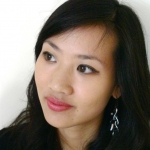When democracy stumbles
Washington - It was always going to be a big day in Washington. Both houses of Congress were to meet to certify President-elect Joe Biden's November victory - a normally ceremonial event which had taken on outsized significance in light of Donald Trump's unprecedented refusal to concede defeat. Ultimately, the day would go down in history for the storming of the US Capitol by a pro-Trump mob, its jaw-dropping scenes captured at close quarters by AFP's 17-strong team of reporters, photographers and videojournalists on the ground.
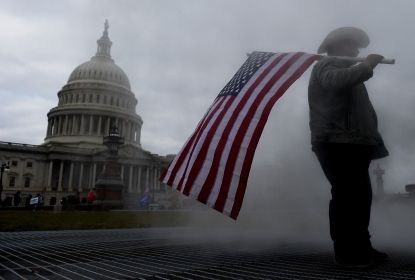 (AFP / Olivier Douliery)
(AFP / Olivier Douliery)Around 9 am on Wednesday, photographers Saul Loeb and Olivier Douliery passed through checkpoints into the Capitol complex. “It was basically like any other day on Capitol Hill for security,” said Saul, 37, who has won a string of awards for his political coverage spanning three previous US presidencies. “That was a bit surprising. It was well known there was going to be large groups of protesters coming.”
Inside the Capitol building, hundreds of lawmakers were gathering in a rare joint session of the 100-strong Senate and 435-strong House of Representatives called to certify Biden's win. Several Republicans had vowed to challenge the process and Trump himself -- crying fraud without evidence -- had been pressuring his loyal deputy Mike Pence to somehow invalidate the count.
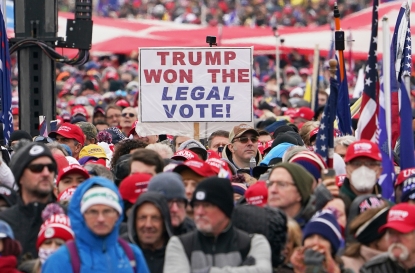 (AFP / Mandel Ngan)
(AFP / Mandel Ngan)At the other end of the Washington Mall -- Trump was preparing to speak to thousands of supporters rallying near the White House, who travelled from all corners of America to "defend" the president and to "Stop the Steal." Trump fans have embraced the slogan, convinced by his debunked claims that November’s polls were rigged to favor Biden.
As Saul and Olivier were setting up, photographer Roberto Schmidt and video journalist Agnes Bun joined the throngs of Trump fans. “There were thousands of people. They seemed energized, and most of them were not wearing masks. When Trump arrived, they were ecstatic,” recalled Roberto, a German-Colombian veteran photographer. “He spoke and he spoke, and then he invited them to march to the Capitol.”
Several in the crowd were well known to AFP's team -- sighted at one or other of Trump's scores of rallies.
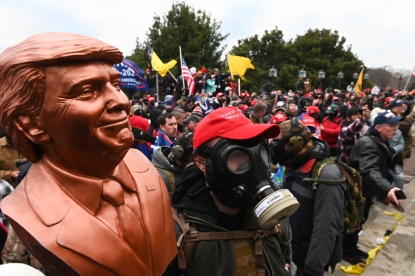 (AFP / Roberto Schmidt)
(AFP / Roberto Schmidt)One stood out: shirtless in face paint and a fur hat complete with buffalo horns. Jake Angeli -- whose image would quickly go around the world -- had been photographed by AFP at Trump events in both Arizona and Georgia.
Angeli was charged in connection with the riots at the U.S. Capitol on Saturday, January 9th, and taken into custody. The man portrays himself as a digital soldier of QAnon, the conspiracy that claims Trump is waging a secret war against a global liberal cult of Satan-worshipping pedophiles. “We're patriots on the front lines in Arizona who wish to take our positive energy to DC,” Angeli wrote on the ultra-conservative social network Parler in December.
Others in the crowd described themselves as “white nationalists” or “libertarians”. As Trump angrily rehearsed his election grievances, he further whipped up the crowd, even as the vice president publicly rebuffed his call to “do the right thing” and step in to block the certification of Biden's win.
“We’re going to walk down Pennsylvania Avenue... and we're going to try and give our Republicans... the kind of pride and boldness that they need to take back our country,” Trump vowed. “All of us here today do not want to see our election victory stolen by emboldened radical left Democrats,” he said. “We will stop the steal.”
By midday, Roberto had gone a short distance from the rally to transmit some images back to the AFP newsroom. “Then I heard the sound of detonations, so I quickly went back to the Congress,” Roberto recalls. “I saw how the crowd had pushed over barriers around the building ... There were not enough police officers.”
 (AFP / Roberto Schmidt)
(AFP / Roberto Schmidt)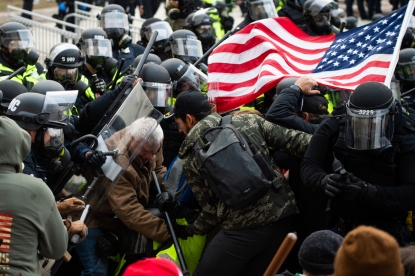 (AFP / Roberto Schmidt)
(AFP / Roberto Schmidt)“I looked for a high position from which I could shoot what was happening.”
Agnes, who has covered countless Trump rallies in the past, says her biggest concern is typically catching Covid-19 -- many Trump supporters shun masks and social distancing, and believe the media exaggerate the pandemic’s severity. “However, I realized this gathering was going to be different. Even before storming the Capitol, Trump supporters standing on the lawn outside were already agitated,” she says.
“They kept shouting insults at every reporter they could spot. I positioned myself near a group of journalists, to ensure that I would not be by myself should protesters grow more aggressive. Sadly, this proved to be the case; I saw a Trump supporter spit near the feet of a correspondent who was doing his piece to camera; they also yelled anti-China and racist slurs at Asian-looking reporters. As a French journalist of Asian origin, I started to grow very uneasy, and was glad the mask I was wearing was partly hiding my face.”
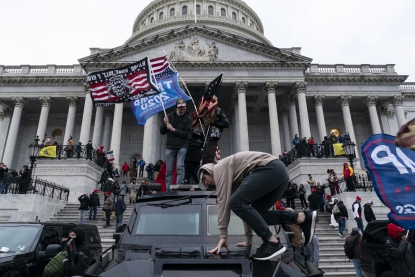 (AFP / Alex Edelman)
(AFP / Alex Edelman)“When protesters broke down police barricades and started to run towards the steps of the Capitol in the early afternoon, I could hardly believe what I was filming. I kept thinking that the police would push them back, but the opposite happened, and, astonished, I captured live the moment when they stormed inside the building.”
Agnes, along with videographer Diane Desobeau, saw angry demonstrators surround a group of journalists, many of whom were forced to flee and abandon their equipment that was soon destroyed by the mob. “I have seldom faced such pure hatred against reporters. (Wednesday’s) events sadly proved that we, as journalists, are being increasingly threatened and targeted worldwide, even in a democratic country, while we try to document events unfolding around us in challenging circumstances,” Agnes said.
Inside the Capitol, Saul Loeb was sending photos during a recess in formal proceedings when suddenly loudspeakers started blaring a warning. “There was an announcement saying there was a security situation inside the building, shelter in place,” he recalled. Demonstrators started pouring into the front and back of the Capitol. Roberto Schmidt followed them and captured these images.
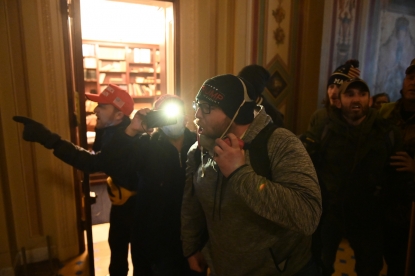 (AFP / Roberto Schmidt)
(AFP / Roberto Schmidt)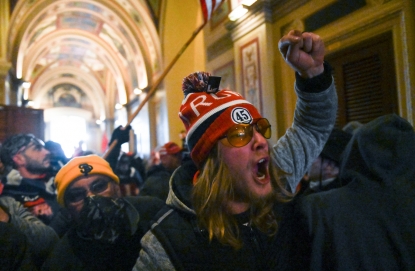 (AFP / Roberto Schmidt)
(AFP / Roberto Schmidt)“I heard some commotion, some shouting … there was a dozen or so protesters right outside the (Senate) chamber,” Saul said.
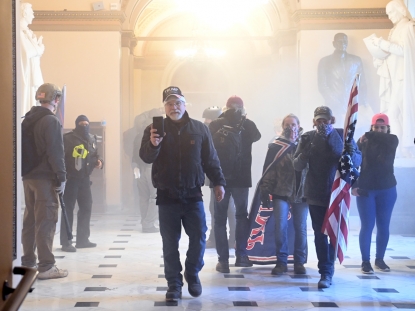 (AFP / Saul Loeb)
(AFP / Saul Loeb)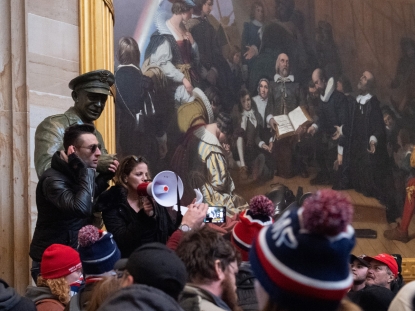 (AFP / Saul Loeb)
(AFP / Saul Loeb)But the number of protesters inside the building quickly swelled to several hundred, young and old, many of them dressed in "Make America Great Again" gear or combat fatigues.
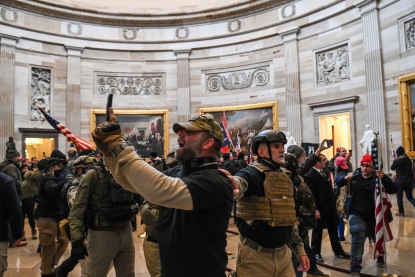 (AFP / Saul Loeb)
(AFP / Saul Loeb)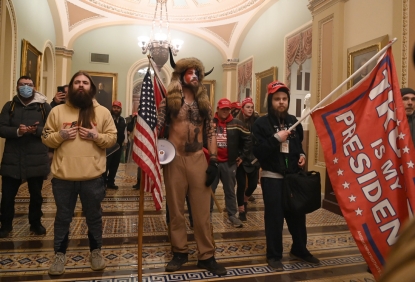 (AFP / Saul Loeb)
(AFP / Saul Loeb)Around this time, police started to evacuate Congressional staff and lawmakers, in scenes captured by two photographers from Getty, a partner AFP agency.
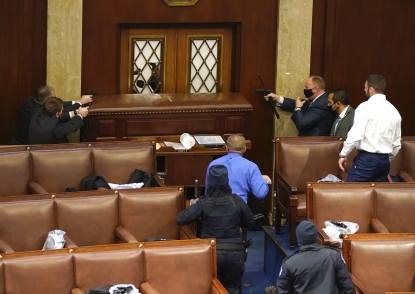 (GETTY IMAGES / AFP Drew Angerer)
(GETTY IMAGES / AFP Drew Angerer)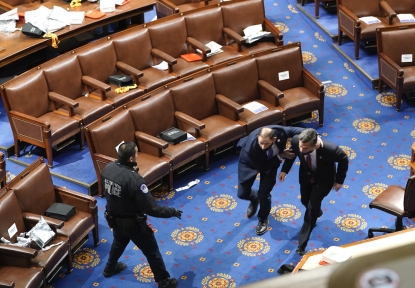 (GETTY IMAGES / AFP / Drew Angerer)
(GETTY IMAGES / AFP / Drew Angerer)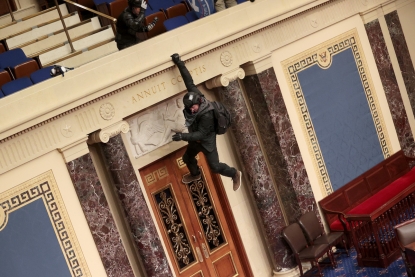 (GETTY IMAGES / AFP / Win Mcnamee)
(GETTY IMAGES / AFP / Win Mcnamee)“There were a lot of rumors about what was going on outside,” recalls photographer Olivier Douliery. Before the building was cordoned off, “I decided to look for a place to photograph the crowd outside from another point of view. “I knocked on doors. At one point I ventured up a spiral staircase, which led to a dead-end corridor, and found an office there which had an ideal, central position to photograph the crowd. That’s when I learned that protesters were coming in.”
He tried to rejoin Saul, only to see a group of Trump supporters brandishing flags already on the spiral staircase. “I decided to turn back and warn the Congressional staff in the office that the demonstrators were coming,” Olivier said.
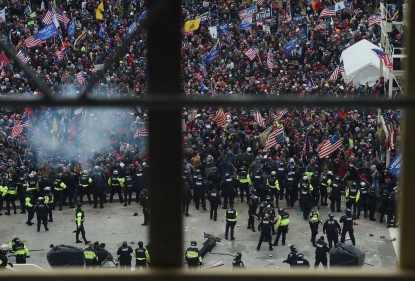 (AFP / Olivier Douliery)
(AFP / Olivier Douliery)Those workers decided to barricade themselves in their offices. They used tables and chairs, moving them quietly to avoid attracting attention. “Then we learned in a text message that there had been a gunshot. We did not really know what was happening. One TV was showing CNN, but we had the sound down to keep quiet.” The news network soon stopped showing images from inside as it had become too dangerous for their team. “I was stuck. At first I thought I was going to miss all the action, then I reflected a bit and realized that since I was with this group, I would tell their story.”
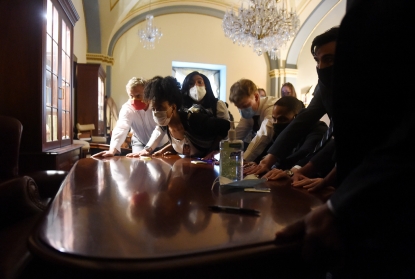 (AFP / Olivier Douliery)
(AFP / Olivier Douliery)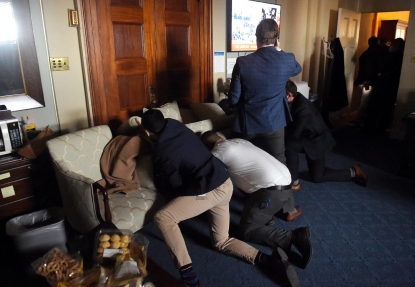 (AFP / Olivier Douliery)
(AFP / Olivier Douliery)Olivier’s images, like Saul’s, were quickly picked up by news organizations around the world. As Saul was photographing the demonstrators, Olivier showed what was happening behind closed doors, where staffers were hiding. It was photojournalism 101: shooting the action and the reaction.
Saul, making the most of his knowledge of the Capitol and its many corridors and passageways, ranged the building photographing demonstrators. “They were mostly either ignoring us or letting us photograph them,” Saul said. “They were sort of in a jovial mood, they were happy to be there. … I don’t know what their plan was, I think they didn’t really expect to be there maybe. Everyone was trying to figure out what was going to happen next.”
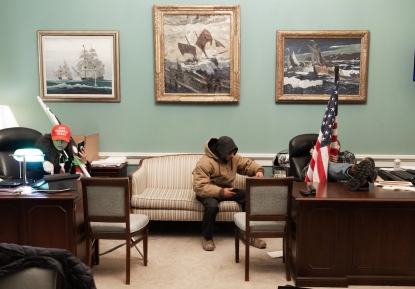 (AFP / Saul Loeb)
(AFP / Saul Loeb)Saul then went to the offices of Nancy Pelosi, the Speaker of the House of Representatives and third-in-line for the presidency. “Normally nobody can go into her office at all without an appointment, there is usually Capitol Police standing outside. In this case, anybody can wander in there and do whatever they want,” Saul said.
“I saw some protesters in there, people in MAGA hats taking selfies, streaming videos on social media sites and just going through her office and looking at all her things, at her mementos, looking through drawers and just checking everything out.” The group of about 10 people acted like the room belonged to them. One woman protester lit up a cigarette. “That’s when I encountered one of the protesters sitting in a staffer's desk and putting his feet up, looking through (Pelosi’s) papers. That's the picture that a lot of people have seen now,” Saul said.
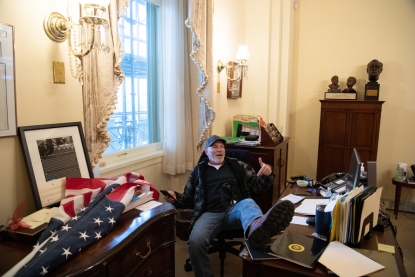 (AFP / Saul Loeb)
(AFP / Saul Loeb)The image has come to symbolize Wednesday’s events and the affront to America’s democratic institutions. One protester left a note: We will not back down.
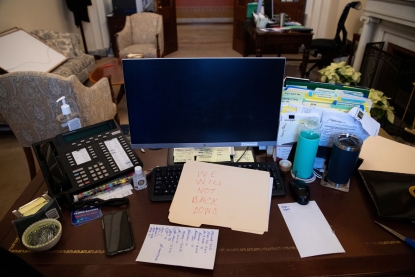 (AFP / Saul Loeb)
(AFP / Saul Loeb)
Meanwhile, Olivier was sending images from inside in the barricaded offices. “Every now and then I would look out the window, and I would see protesters climbing all over the place,” he says. “At one point we heard more detonations, probably tear gas. Then came the confirmation of the first death, a protester. The atmosphere in the offices was strange. No one was speaking. Everyone was in their corner on their phone. Suddenly, it was calm. And then, a little later, we heard more screams.”
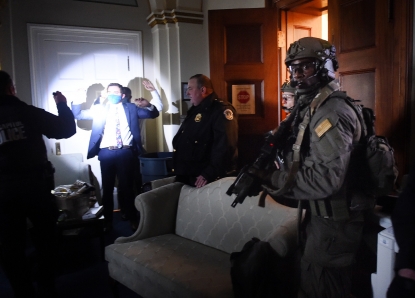 (AFP / Olivier Douliery)
(AFP / Olivier Douliery)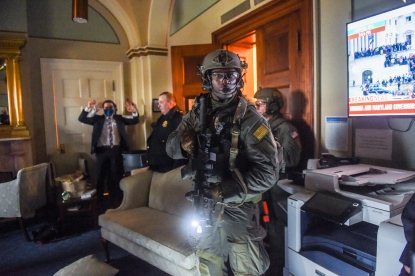 (AFP / Olivier Douliery)
(AFP / Olivier Douliery)Police ! Police ! Open up! “Everyone was hesitant. What if it was protesters posing as cops? But the decision was made to open the doors. We pulled back the couches that had been used as barricades and police in combat gear came in, yelling ‘Hands up!’
“I kept shooting. It was surreal. They went through every office looking for demonstrators. They asked to see our credentials and then sent us out of the building. We were escorted through a series of narrow tunnels by armed officers who had already secured these evacuation routes.”
As events unfolded, the assault on the Capitol was characterized by several lawmakers as an attempted “coup”. Roberto Schmidt thinks that’s a bit of a stretch.
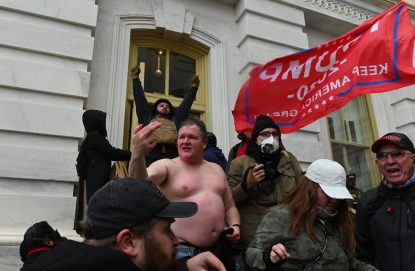 (AFP / Roberto Schmidt)
(AFP / Roberto Schmidt)“They clearly wanted to wreak havoc outside, but none of them expected to cross the police lines,” Roberto says. “When they met with little police resistance, they carried on. Seeing them stroll through Congress reminded me of an experience in Haiti years ago when I saw a crowd of people invade a luxury hotel. All the people wanted was a swim in the pool!”
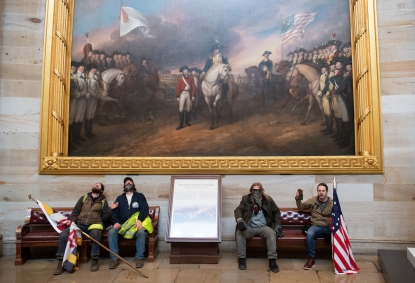 (AFP / Saul Loeb)
(AFP / Saul Loeb)Gradually, authorities regained control of the building, clearing small spaces at a time before moving on. “US democracy is fragile. None of what happened is surprising. Politicians have for years allowed this movement to grow, giving it oxygen,” says Schmidt.
Once the Congress was secured, Saul Loeb and Olivier Douliery returned to the Congressional session where shaken lawmakers resumed their session at 8 pm, determined to finish what they had begun.
 (AFP / Getty Images / Drew Angerer)
(AFP / Getty Images / Drew Angerer)Pence did not yield to Trump's pressure, the Electoral College vote count of 306 to 232 was duly certified, and -- at past 3.30 am -- Biden was confirmed as America's 46th president and Kamala Harris as its first Black and first female vice president of the United States.
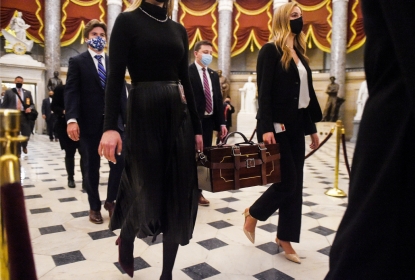 Senate pages carry the Electoral College ballot boxes, at the Capitol, on January 7, 2021 in Washington, DC. (AFP / Olivier Douliery)
Senate pages carry the Electoral College ballot boxes, at the Capitol, on January 7, 2021 in Washington, DC. (AFP / Olivier Douliery)If the protesters had an influence on the proceedings, it was the opposite of what they intended: while they delayed the certification by a few hours, several senators dropped or scaled-back their opposition in horror at the day's events.
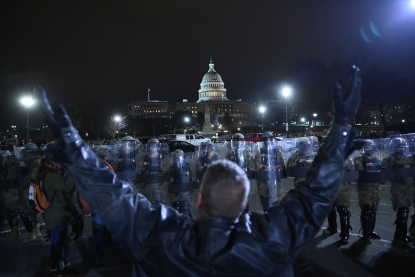 (AFP / Brendan Smialowski)
(AFP / Brendan Smialowski)AFP’s team packed up between 4 and 6 am, and headed home in the cold pre-dawn of a capital under curfew following the day's violence. By the next day, the Capitol complex was surrounded by "unscalable" barriers -- like the ones that sprung up around the White House a few months earlier as anti-racism protests roiled the capital.
This blog was written with Michaela Cancela-Kieffer in Paris and Thomas Watkins in Washington DC







